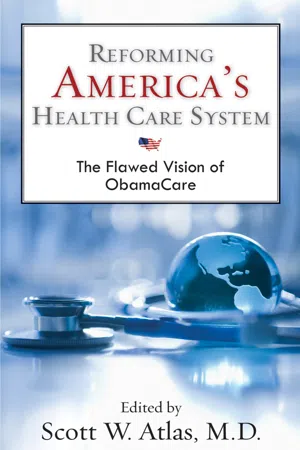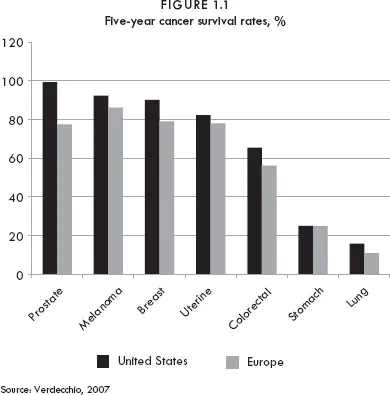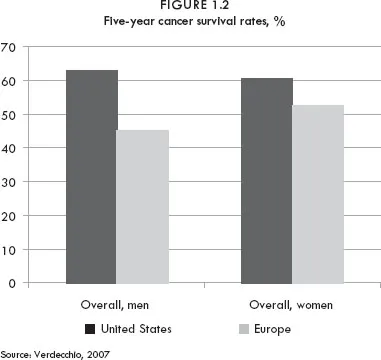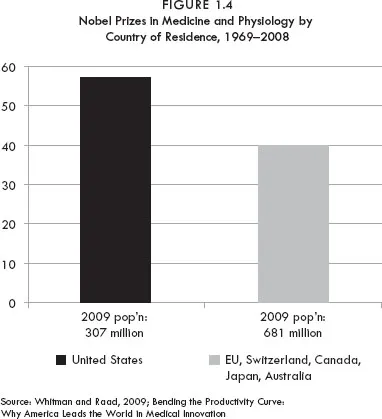
- 216 pages
- English
- ePUB (mobile friendly)
- Available on iOS & Android
eBook - ePub
About this book
Health policy experts from the United States, Canada, and Western Europe discuss both what to expect from the recent health reform legislation and alternatives that should still be considered. The contributors argue that Americans already have a superior health care system and that if Congress enacts reforms that remove artificial barriers and constructively open markets to competition, private-sector creativity will generate innovative, low-cost insurance products for tens of millions of consumers.
Frequently asked questions
Yes, you can cancel anytime from the Subscription tab in your account settings on the Perlego website. Your subscription will stay active until the end of your current billing period. Learn how to cancel your subscription.
At the moment all of our mobile-responsive ePub books are available to download via the app. Most of our PDFs are also available to download and we're working on making the final remaining ones downloadable now. Learn more here.
Perlego offers two plans: Essential and Complete
- Essential is ideal for learners and professionals who enjoy exploring a wide range of subjects. Access the Essential Library with 800,000+ trusted titles and best-sellers across business, personal growth, and the humanities. Includes unlimited reading time and Standard Read Aloud voice.
- Complete: Perfect for advanced learners and researchers needing full, unrestricted access. Unlock 1.4M+ books across hundreds of subjects, including academic and specialized titles. The Complete Plan also includes advanced features like Premium Read Aloud and Research Assistant.
We are an online textbook subscription service, where you can get access to an entire online library for less than the price of a single book per month. With over 1 million books across 1000+ topics, we’ve got you covered! Learn more here.
Look out for the read-aloud symbol on your next book to see if you can listen to it. The read-aloud tool reads text aloud for you, highlighting the text as it is being read. You can pause it, speed it up and slow it down. Learn more here.
Yes! You can use the Perlego app on both iOS or Android devices to read anytime, anywhere — even offline. Perfect for commutes or when you’re on the go.
Please note we cannot support devices running on iOS 13 and Android 7 or earlier. Learn more about using the app.
Please note we cannot support devices running on iOS 13 and Android 7 or earlier. Learn more about using the app.
Yes, you can access Reforming America's Health Care System by Scott W. Atlas in PDF and/or ePUB format, as well as other popular books in Medicine & Health Care Delivery. We have over one million books available in our catalogue for you to explore.
Information
1
AMERICAN HEALTH CARE: IGNORED FACTS AND DISREGARDED OPTIONS
Scott Atlas is a senior fellow at the Hoover Institution and professor at Stanford University Medical Center. He can be reached at [email protected].
MEDICAL CARE in the United States has been loudly derided as inferior in comparison to health care systems in the rest of the developed world in highly publicized rankings, most notably the World Health Organization's World Health Report comparing health care in almost two hundred nations. These rankings have gained tremendous traction, despite being exposed in leading academic journals for gross distortions from severe methodological flaws, including huge measurement errors that produce results with no statistical significance, data missing from dozens of countries, biased assumptions, and extreme subjectivity.1 Government officials, policymakers, insurers and even many academics used this pseudo-data to justify their personal agenda centralizing power over health care to government by imposing the radical changes to America's health care contained in the Patient Protection and Affordable Care Act (also known as “ObamaCare”) on a largely unwilling public.
Why has the public remained steadfast in its opposition to the reforms imposed by Congress and President Obama? On one hand, much of the American public still assumes the criticisms of our system are sound, because the calls for change have been so ubiquitous and the topic so complex. Indeed, a large majority of Americans have repeatedly concurred that their health care system needs “fundamental change” or “complete rebuilding.”2 Yet despite that general opinion, in multiple studies, over 80 percent of Americans are satisfied with the quality of their own health care, a number rising steadily over the past several years.3 (This striking contradiction in public opinion, while ignored by policymakers calling for radical changes in the debate over the state of America's health care, reveals the fundamental truth: Americans understand, from personal experience, that American medical care is the best in the world. Americans understand what they could lose in a government-centralized health system in which government is empowered to exercise unprecedented control over the most personal decisions in the lives of individuals.
IGNORED FACTS: AMERICAN HEALTH CARE IS SUPERIOR
The reality, from analysis of facts, is that American health care is superior. This inescapable conclusion derives from actual data, not opinion. The world's leading journals are filled with studies demonstrating the superiority of American medical care to care found in other countries with systems more heavily controlled by government bodies. These studies verify better survival from serious diseases like cancer, better access to treatment for the most prevalent chronic diseases, wider access to preventive care and cancer screening, broader availability of the newest life-changing medical technology, wider access to the most accurate diagnostic technology, quicker access to innovative, life-saving cures and safer, less invasive treatments, more rapid access to highly trained specialists, and ultimately far better access to the world's leading doctors and medical scientists who themselves are the source of the world's leading innovations by any metric examined.
Before accepting a radical overhaul of the world's leading medical care system, and instead of turning to government as the solution to the widely recognized problems of health care, these important unheralded facts about America's health care system should be carefully considered.
Fact No. 1: Americans have better survival rates than Europeans for most common as well as rare cancers.4 (See Figure 1.1.) Among more common cancers, the breast cancer mortality rate is 52 percent higher in Germany than in the United States, and 88 percent higher in the United Kingdom. Prostate cancer mortality is strikingly higher in the UK and in Norway. Age-standardized death rates from prostate cancer from 1980–2005 have been reduced far faster in the United States than in the fifteen other developed nations studied, attesting to superior outcomes in what is the most common cancer among men.5 The mortality rate for colorectal cancer among British men and women is about 40 percent higher. Americans, whether men or women, enjoy superior overall survival from cancer than western Europeans. (See Figure 1.2.)

Fact No. 2: Americans have lower cancer mortality rates than Canadians.6 Breast cancer mortality is 9 percent higher, for example; prostate cancer is 184 percent higher; and colon cancer mortality among men is about 10 percent higher than in the United States.

Fact No. 3: Americans have better access to treatment for chronic diseases than patients in other developed countries.7 Some 56 percent of Americans who could benefit are taking statins, which reduce cholesterol and protect against heart disease. By comparison, of those patients who could benefit from these drugs, only 36 percent of the Dutch, 29 percent of the Swiss, 26 percent of Germans, 23 percent of Britons, and 17 percent of Italians receive them.
Fact No. 4: Americans have better access to preventive cancer screening than Canadians.8 Take the proportion of the appropriate-age population groups who have received recommended tests for breast, cervical, prostrate and colon cancer:
• Nine out of ten middle-aged American women (89 percent) have had a mammogram, compared to less than three-fourths of Canadians (72 percent).
• Nearly all American women (96 percent) have had a pap smear, compared to less than 90 percent of Canadians.
• More than half of U.S. men (54 percent) have had a PSA test, compared to less than 1 in 6 Canadians (16 percent).
• Nearly one-third of Americans (30 percent) have had a colonoscopy, compared with less than 1 in 20 Canadians (5 percent).
Fact No. 5: Lower-income Americans are in better health than comparable Canadians. It is often claimed that government-financed health care systems, such as Canada's, eliminate income-related barriers to health. The “health-income gradient” (i.e. the concept that higher income achieves better health, and lower income means worse health) for adults 16 to 64 years old reveals a more severe disparity in Canada than in the United States. Specifically, twice as many American seniors with below-median incomes self-report “excellent” health compared to Canadian seniors (11.7 percent versus 5.8 percent). Conversely, white Canadian young adults with below-median incomes are 20 percent more likely than lower-income Americans to describe their health as “fair or poor.”9
Fact No. 6: Americans spend much less time waiting than patients in Canada and the UK—to see a specialist, to have life-changing elective surgery like hip replacements or cataract removal, or to get radiation treatment for cancer.10 All told, 827,429 people are waiting for some type of procedure in Canada.11 In England, nearly 1.8 million people are waiting for a hospital admission or outpatient treatment.12
Fact No. 7: Americans are not alone, among residents of developed countries, in believing their health systems need major reforms. The unspoken truth is that those with more government control of their health systems, the very countries purported to serve as the models for a reformed American system, are similarly highly dissatisfied and believe their own health systems need fundamental change or complete rebuilding. (See Figure 1.3.) More than 70 percent of German, Canadian, Australian, New Zealand and British adults, say their health systems need either “fundamental change” or “complete rebuilding,”13 and 60 percent of western Europeans say their systems need “urgent” reform.14
Fact No. 8: Americans are more satisfied with the care they receive than Canadians, a highly government-controlled health system often portrayed by the media as a system to emulate. When asked directly about their own health care instead of the “health care system,” more than half of Americans (51.3 percent) are very satisfied with their health care services, compared to only 41.5 percent of Canadians; fewer Americans are dissatisfied (6.8 percent) than Canadians (8.5 percent).15
Fact No. 9: Americans have much better access to important new technologies like medical imaging than patients in Canada or the UK. An overwhelming majority of leading American physicians say computerized tomography (CT) and magnetic resonance imaging (MRI), which have been maligned as a waste by economists and targeted by the Congress and many policymakers naïve to actual medical practice, were the most important medical innovations for improving patient care during the previous decade.16 The United States has thirty-four CT scanners per million population, compared to twelve in Canada and eight in Britain. The United States has nearly twenty-seven MRI machines per million compared to about six per million in Canada and Britain.17

Fact No. 10: By any variety of measures, Americans are responsible for the vast majority of all health care innovations, innovations from which the entire world benefits.18 The top five U.S. hospitals conduct more clinical trials than all the hospitals in any other single developed country.19 Since the mid-1970s, the Nobel Prize in medicine or physiology has gone to American residents more often than recipients from all other countries combined.20 (See Figure 1.4.) From 1969 to 2008, Americans (2009 population 307 million) won or shared the Nobel Prize in Medicine and Physiology fifty-seven times compared with forty times by medical scientists from the European Union, Switzerland, Japan, Canada, and Australia combined (2009 population 681 million).21 Indeed, of the past thirty-four years, there were only five years in which a scientist living in America didn't either win or share in the prize.
DISREGARDED OPTIONS: INDIVIDUAL EMPOWERMENT NOT GOVERNMENT CENTRALIZATION
Regardless of the amazing quality of medical care that has evolved over the past half century and even acknowledging that the U.S. health care system compares favorably to those in other developed countries, there is a broad consensus on a number of significant problems in American health care. It is inarguable that costs are high and increasing. It is also clear that government and society cannot continue to spend such huge sums of money and large proportion of GDP on health care. The lack of portability of health insurance in the American system, which largely relies on employers for insurance, needs to be changed. The fact that millions of Americans are uninsured must be addressed.

The Democrat Congress and the Obama administration claim that a major principle underlying their health reform law rests on the goal of increasing competition among health insurance providers. Increasing competition would seem to be a fundamental means of reducing cost, but to the contrary the new legislation will only centralize power to the government. The health legislation passed by the Congress and the Obama administration creates massive new government authority that controls access to medical care and insurance benefits. Rather than increasing private sector competition, the legislation will reduce choice, shift more regulatory power to bureaucrats, hinder innovation, and ultimately be likely to serve as a rationale for shifting Americans to public plans that restrict access to care.
The overall goal of any health reform plan should be to increase the opportunity for good health for Americans and their families. Key principles include reducing the number of uninsured, facilitating access to affordable health insurance, making health insurance more portable, and promoting innovation in health care, so that the excellence of American health care is not sacrificed and individuals and their families are empowered to decide how best to spend their money in health care decisions. Here are six straight-forward steps the government could take, right now, that would increase the competitiveness in the health insurance markets and empower consumers so costs come down by value-based purchasing rather than government edict. These reforms will reduce the number of uninsured, facilitate access to affordable insurance, make health insurance portable, and promote innovation in health care.
A first step to increasing competitiveness in the health insurance market is to allow cross-state purchasing, so that people can shop at competitive prices in a national market for the insurance they actually want to buy. It is ill-conceived, unnecessary, and self-defeating to the goal of encouraging competition that Americans are forced to restrict their purchases to in-state goods or services. Government can rapidly lower the price of health insurance through the private insurance market by breaking down these anti-competitive barriers that result in shocking variations on the order of several multiples among states in prices for equivalent health coverage. One specific and immediate action would be to allow small businesses to band together in trade associations to purchase coverage for their employees. If regulated by the Employee Retirement Income Security Act of 1974 (ERISA), they would be exempt from state health insurance mandates and regulations. Just like large businesses, America's small businesses need this capacity now, so their employees can save money by getting the coverage they actually want instead of bloated plans they don't desire. Since small business employees make up the biggest proportion of uninsured workers, this one change would have high impact.
Second, government can force transparency on the system, ensuring that Americans have a clear understanding of the price and quality of their doctors and hospitals, as well as enough information about health and diseases to make informed, value-conscious decisions. Let's leave the experts—medical scientists in their peer-reviewed literature—to determine efficacy and clinical utility. A far more important role of the government needs to be explored: to make transparent the pricing of medical procedures. Public knowledge of price will provide an important impetus toward competitive pricing by both physicians and hospitals. In our current system, few patients are aware of the charges about to be incurred for their medical care. Generally, they have no reason to ask because the current third-party-payer structure makes patients believe that “someone else is paying.” The lack of patient demand for price information has allowed hospitals and doctors to cloak their price structure in a shroud of mystery and avoid public view. A powerful role of the government could be to require posting of prices for medical procedures and services, as well as qualifications of doctors. Information is power, and price visibility is essential to induce competition.
Third, it is time to reduce the mandate-created distortions of health insurance markets. State-based mandates alone now number over 2,100 and are a scandalous abuse of government dictates. They increase insurance costs by 20 to 50 percent, and force Americans to buy policies covering massage therapy, acupuncture, chiropractors, in vitro fertilization, wigs, and other services not necessarily wanted by more than a small minority of...
Table of contents
- Cover
- Title Page
- Copyright Page
- Dedication
- Contents
- Foreword
- Preface
- 1. American Health Care: Ignored Facts and Disregarded Options
- 2. Individual Insurance Mandates
- 3. Health Savings Accounts and The Future of Insurance Choice
- 4. Medical Innovation in Peril
- 5. The Real Math of Congressional Budget Office Estimates
- 6. The Imperfect Art of Medical Malpractice Reform
- 7. Lessons From State Health Reforms
- 8. Government Control on Access to Care: Canada's Experience
- 9. Government Oversight of Comparative Effectiveness: Lessons from Western Europe
- About the Contributing Authors
- About the Hoover Institution's Working Group on Health Care Policy
- Index